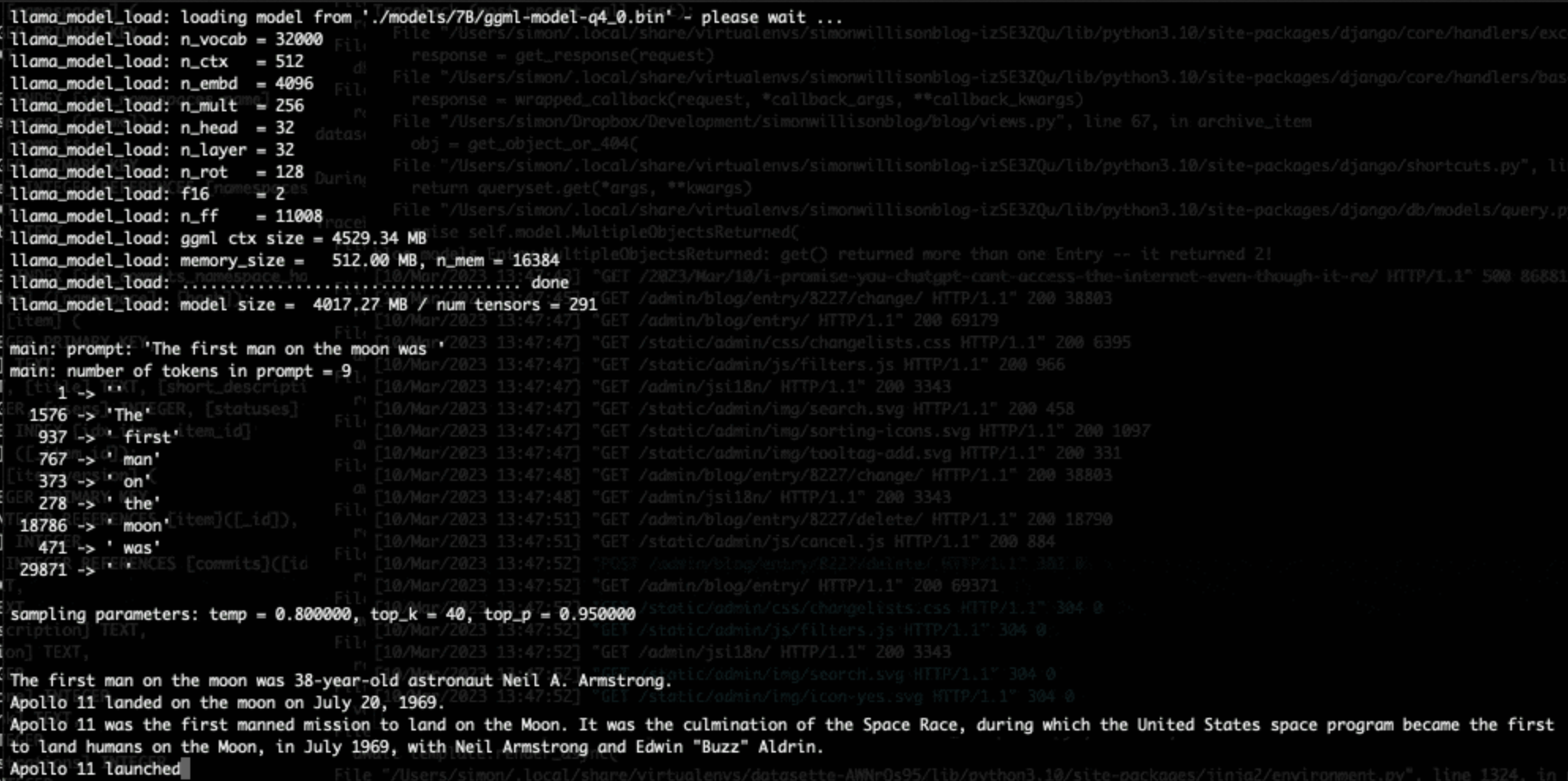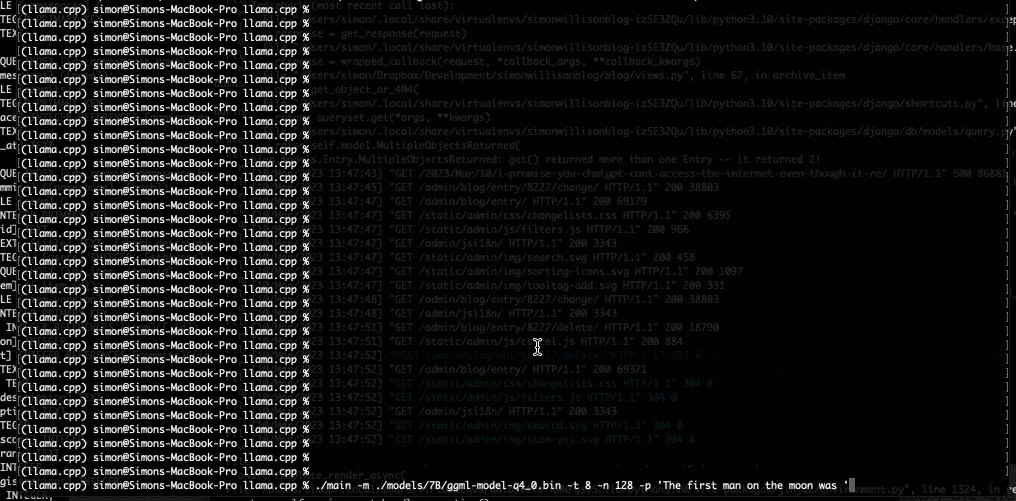You are using an out of date browser. It may not display this or other websites correctly.
You should upgrade or use an alternative browser.
You should upgrade or use an alternative browser.
The A.I Megathread (LLM , GPT , Development)
More options
Who Replied?this is dope, using it now
All of this shyt is a game game changer with the right implementation.
Wild that big tech was pushing AR like crazy and now AI has leveled up and is unstoppable. Neither is super mainstream at this point but you are seeing way more AI uses even if if just for fukkery purposes.
Too bad crypto shyt the bed otherwise developers could have used tokens to fund these projects. That would have been an actual utility.
All of this shyt is a game game changer with the right implementation.
Wild that big tech was pushing AR like crazy and now AI has leveled up and is unstoppable. Neither is super mainstream at this point but you are seeing way more AI uses even if if just for fukkery purposes.
AR with A.I will be dope.

Large language models are having their Stable Diffusion moment
The open release of the Stable Diffusion image generation model back in August 2022 was a key moment. I wrote how Stable Diffusion is a really big deal at the …
simonwillison.net
Large language models are having their Stable Diffusion moment
The open release of the Stable Diffusion image generation model back in August 2022 was a key moment. I wrote how Stable Diffusion is a really big deal at the time.People could now generate images from text on their own hardware!
More importantly, developers could mess around with the guts of what was going on.
The resulting explosion in innovation is still going on today. Most recently, ControlNet appears to have leapt Stable Diffusion ahead of Midjourney and DALL-E in terms of its capabilities.
It feels to me like that Stable Diffusion moment back in August kick-started the entire new wave of interest in generative AI—which was then pushed into over-drive by the release of ChatGPT at the end of November.
That Stable Diffusion moment is happening again right now, for large language models—the technology behind ChatGPT itself.
This morning I ran a GPT-3 class language model on my own personal laptop for the first time!
AI stuff was weird already. It’s about to get a whole lot weirder.
LLaMA
Somewhat surprisingly, language models like GPT-3 that power tools like ChatGPT are a lot larger and more expensive to build and operate than image generation models.The best of these models have mostly been built by private organizations such as OpenAI, and have been kept tightly controlled—accessible via their API and web interfaces, but not released for anyone to run on their own machines.
These models are also BIG. Even if you could obtain the GPT-3 model you would not be able to run it on commodity hardware—these things usually require several A100-class GPUs, each of which retail for $8,000+.
This technology is clearly too important to be entirely controlled by a small group of companies.
There have been dozens of open large language models released over the past few years, but none of them have quite hit the sweet spot for me in terms of the following:
- Easy to run on my own hardware
- Large enough to be useful—ideally equivalent in capabilities to GPT-3
- Open source enough that they can be tinkered with
Here’s the abstract from the LLaMA paper:
It’s important to note that LLaMA isn’t fully “open”. You have to agree to some strict terms to access the model. It’s intended as a research preview, and isn’t something which can be used for commercial purposes.We introduce LLaMA, a collection of founda- tion language models ranging from 7B to 65B parameters. We train our models on trillions of tokens, and show that it is possible to train state-of-the-art models using publicly available datasets exclusively, without resorting to proprietary and inaccessible datasets. In particular, LLaMA-13B outperforms GPT-3 (175B) on most benchmarks, and LLaMA-65B is competitive with the best models, Chinchilla- 70B and PaLM-540B. We release all our models to the research community.
In a totally cyberpunk move, within a few days of the release, someone submitted this PR to the LLaMA repository linking to an unofficial BitTorrent download link for the model files!
So they’re in the wild now. You may not be legally able to build a commercial product on them, but the genie is out of the bottle. That furious typing sound you can hear is thousands of hackers around the world starting to dig in and figure out what life is like when you can run a GPT-3 class model on your own hardware.
llama.cpp
LLaMA on its own isn’t much good if it’s still too hard to run it on a personal laptop.Enter Georgi Gerganov.
Georgi is an open source developer based in Sofia, Bulgaria (according to his GitHub profile). He previously released whisper.cpp, a port of OpenAI’s Whisper automatic speech recognition model to C++. That project made Whisper applicable to a huge range of new use cases.
He’s just done the same thing with LLaMA.
Georgi’s llama.cpp project had its initial release yesterday. From the README:
4-bit quantization is a technique for reducing the size of models so they can run on less powerful hardware. It also reduces the model sizes on disk—to 4GB for the 7B model and just under 8GB for the 13B one.The main goal is to run the model using 4-bit quantization on a MacBook.
It totally works!
I used it to run the 7B LLaMA model on my laptop this night, and then this morning upgraded to the 13B model—the one that Facebook claim is competitive with GPT-3.
Here are my detailed notes on how I did that—most of the information I needed was already there in the README.
As my laptop started to spit out text at me I genuinely had a feeling that the world was about to change, again.

I thought it would be a few more years before I could run a GPT-3 class model on hardware that I owned. I was wrong: that future is here already.
Is this the worst thing that ever happened?
I’m not worried about the science fiction scenarios here. The language model running on my laptop is not an AGI that’s going to break free and take over the world.But there are a ton of very real ways in which this technology can be used for harm. Just a few:
- Generating spam
- Automated romance scams
- Trolling and hate speech
- Fake news and disinformation
- Automated radicalization (I worry about this one a lot)
Prior to this moment, a thin layer of defence existed in terms of companies like OpenAI having a limited ability to control how people interacted with those models.
Now that we can run these on our own hardware, even those controls are gone.
How do we use this for good?
I think this is going to have a huge impact on society. My priority is trying to direct that impact in a positive direction.It’s easy to fall into a cynical trap of thinking there’s nothing good here at all, and everything generative AI is either actively harmful or a waste of time.
I’m personally using generative AI tools on a daily basis now for a variety of different purposes. They’ve given me a material productivity boost, but more importantly they have expanded my ambitions in terms of projects that I take on.
I used ChatGPT to learn enough AppleScript to ship a new project in less than an hour just last week!
I’m going to continue exploring and sharing genuinely positive applications of this technology. It’s not going to be un-invented, so I think our priority should be figuring out the most constructive possible ways to use it.
What to look for next
Assuming Facebook don’t relax the licensing terms, LLaMA will likely end up more a proof-of-concept that local language models are feasible on consumer hardware than a new foundation model that people use going forward.The race is on to release the first fully open language model that gives people ChatGPT-like capabilities on their own devices.
Quoting Stable Diffusion backer Emad Mostaque:
Wouldn’t be nice if there was a fully open version eh
Last edited:
Lol at thiscame across an opinion piece that used an A.I generated image instead of commissioning art from a cartoonist.

Trump has entered his fat Elvis stage: MSNBC host
Filling in for Lawrence O'Donnell on Monday, Washington Post columnist Jonathan Capehart discussed Donald Trump's speech at CPAC over the weekend that pledged, "I am your retribution.""The crowd cheered, even if he wasn't playing to a full house," Capehart mocked of the small crowd size at the...www.rawstory.com
Thurgood Thurston III
#LLNB #LLLB #E4R x 2 🖤🖤🖤🆚🌀🌀
Now this is interesting.What if an AI could interpret your imagination, turning images in your mind's eye into reality? While that sounds like a detail in a cyberpunk novel, researchers have now accomplished exactly this, according to a recently-published paper.
Researchers found that they could reconstruct high-resolution and highly accurate images from brain activity by using the popular Stable Diffusion image generation model, as outlined in a paper published in December. The authors wrote that unlike previous studies, they didn’t need to train or fine-tune the AI models to create these images.


Researchers Use AI to Generate Images Based on People's Brain Activity
Researchers found that they could reconstruct high-resolution images from brain activity.www.vice.com

1) Close your eyes and imagine a RED STAR. 2) Open this thread.
Not everyones inner worlds are the same as your own as this experiment will show. There is a very interesting place we can go once we've established where most people sit on the spectrum of mental perception so lets get it.www.thecoli.com
Imagine being able to replay your dreams
What if an AI could interpret your imagination, turning images in your mind's eye into reality? While that sounds like a detail in a cyberpunk novel, researchers have now accomplished exactly this, according to a recently-published paper.
Researchers found that they could reconstruct high-resolution and highly accurate images from brain activity by using the popular Stable Diffusion image generation model, as outlined in a paper published in December. The authors wrote that unlike previous studies, they didn’t need to train or fine-tune the AI models to create these images.


Researchers Use AI to Generate Images Based on People's Brain Activity
Researchers found that they could reconstruct high-resolution images from brain activity.www.vice.com

1) Close your eyes and imagine a RED STAR. 2) Open this thread.
Not everyones inner worlds are the same as your own as this experiment will show. There is a very interesting place we can go once we've established where most people sit on the spectrum of mental perception so lets get it.www.thecoli.com
Recording dreams would be amazing.
